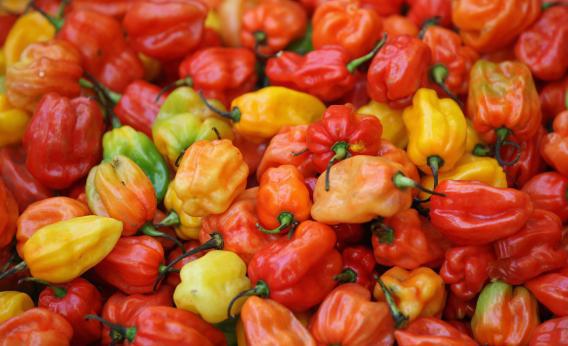If you’ve ever bitten into a raw habanero, eaten a dish laced with Scotch Bonnets, or skinned a basket of roasted New Mexico green chilies, you’re familiar with a roster of physiological effects. These can include a burning mouth, inflamed hands, a runny nose, sweating, heartburn, and, if you’re really unlucky, an upset stomach. Why do chilies cause these symptoms?
They’re all attributable to one molecule found in hot peppers called capsaicin. When you eat chilies or prepare them with your bare hands, capsaicin binds to pain receptors in the nose, mouth, and skin called TRPV1 receptors. TRPV1 receptors are usually activated by heat, but the capsaicin tricks them into reacting as though they’re in the presence of something hot even though there’s no actual rise in temperature.
Once the TRPV1 receptors are activated by the capsaicin, the duplicitous “heat” stimulus is transmitted to the brain through a series of electrical impulses, and we feel a painful burning sensation. The body then reacts to cool itself down—hence the sweating that often accompanies a spicy meal. Redness on your hands and face is another sign of your body attempting to cool off. (Capillaries below the skin dilate in response to the “heat,” and blood rushes through them to move heat to the surface of your body, where it can more easily radiate away.)
In addition to trying to cool itself down, your body does its best to expel the heat-causing element. Your mucous glands step up production in an effort to flush out the offensive substance, leading to a runny nose. Your mouth also produces more saliva to clear capsaicin out of your mouth by making you swallow more frequently. Similarly, if you touch your eyes after preparing chilies, your tear ducts go into overdrive.
As chili-infused food makes its way down your throat, you may experience sensations like heartburn. Usually, it’s not a genuine episode of heartburn (which is typically caused by acid reflux), but the capsaicin binding to the TRPV1 receptors in the esophagus, which prompts a comparable visceral burning sensation. Less frequently, though, capsaicin can cause the lower esophageal sphincter, a muscular valve that opens and closes to allow food into the stomach, to stay open for longer than usual. This allows acid to leak upwards, causing actual heartburn.
When capsaicin reaches the small intestine, pain receptors lining the intestinal walls can trigger the release of the neurotransmitter that stimulates strong rhythmic contractions in the gut—which manifest themselves as painful cramps. This is another defense mechanism to clear out the “heat-causing” contents in the intestine by moving them as quickly as possible towards the colon. Glands along the gut wall also may secrete more fluids, which can sometimes lead to the most unpleasant outcome of chili consumption: diarrhea.
How to mitigate the effects of touching and eating chilies? Capsaicin isn’t water soluble, so washing your hands with water or chugging a glass of it will do little to ease chili-induced burn. Instead, drink cold milk or eat a spoonful of yogurt or sour cream. Dairy contains casein, a protein that pushes capsaicin away from pain receptors and binds to them in its place, bringing almost immediate relief. Additionally, capsaicin is fat-soluble, so if it’s your hands that are burning, you can try soaking them in oil to dissolve the compound. You can also scrub your hands thoroughly with detergent, which will cut through and wash away the capsaicin.
Food Explainer thanks Paul Bosland, director of the Chile Pepper Institute at New Mexico State University and Maged Rizk, M.D., gastroenterologist at Cleveland Clinic.
Previously from the Food Explainer:
Why Are Some Boiled Eggs Easier To Peel Than Others?
Why Does Fish Sauce Have an Expiration Date?
Why Is Cheese Yellow When Milk Is White?
